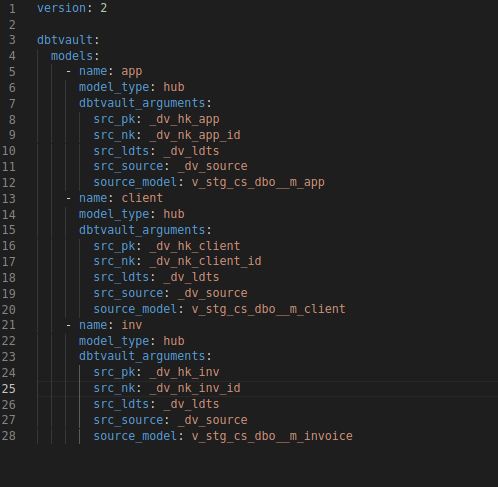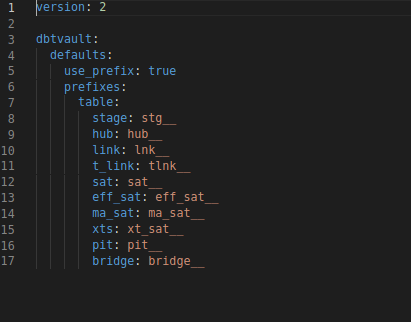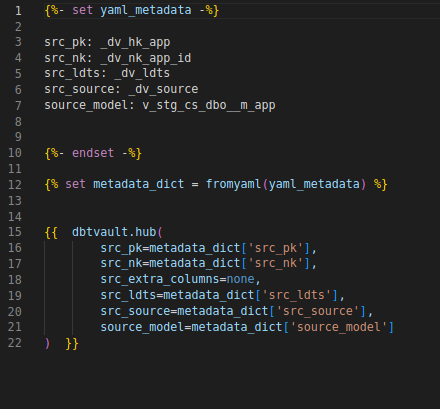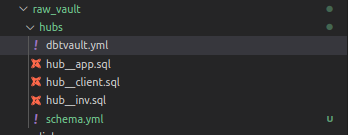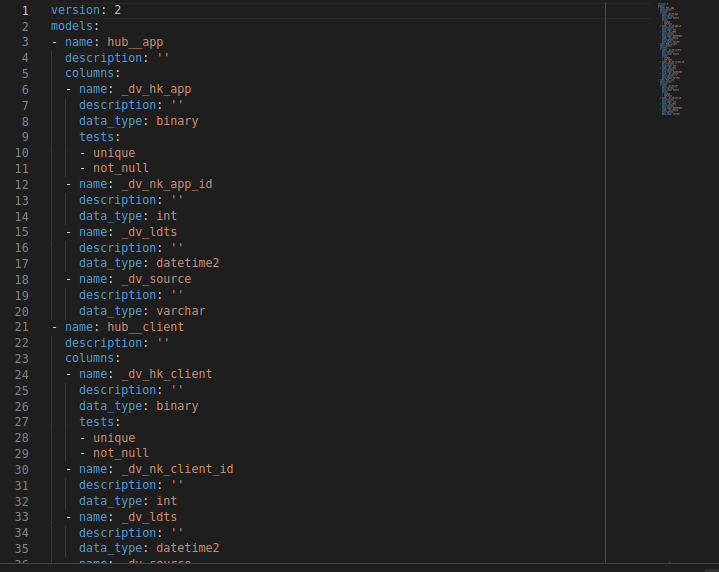Generate DbtVault files from external yml!
A good dev is a lazy dev. Let's do less work, the right way!
DBTVault is a great tool, but due to quirks of DBT (looking at you, compile context) we don't necessarily have access additional variables we want to use...at least, without overloading the meta or vars attributes. See this issue for some details about the limitations and workarounds for the build context. The dbtvault docs used yml specified inside DBT sql files to specify its variables, or otherwise directly set the variables using jinja. While this is a workable solution, it's still a workaround to the fact that additional attributes can't be consumed by the dbt compile operation.
Using env vars as a stopgap isn't a problem on small projects, but on more complicated codebases it can quickly lead to confusion. It becomes difficult to trace which variables belong where. Further, it hinders the development of other data vault management tools being built on top of DBT. Data Vault is a metadata-heavy method of architecting a data warehouse, as the modelling discipline associated with data vault makes it ripe for automation and abstraction. A standardised modelling output format independent of env vars permits the building of GUI tools to streamline the development and expansion of the data vault.
This tool is a Python-based templating library designed to act around DBT and dbtvault, and allow external dbtvault parameterisation. It also seeks to leverage the uniformity of data vault specifications to automate certain low-level maintenance tasks such as code documentation. The primary purpose is to generate Data Vault architectures (trhough dbtvault), generating SQL and schema.yml directly from specialised dbtvault.yml files.
Watch this space for a GUI assistance tool in future.
python>=3.9dbt>=1.0.0available in the Python environment- A DBT project initialised and ready to go. The
dbtv-genCLI tool needs to execute from the same directory as you would normally execute DBT from. - The DBT package
dbtvault>0.9.0installed in the DBT project
Depending on your set-up, install dbtvault-generator into your Python environment. A shim will be installed that adds dbtv-gen to your CLI, and you're ready to go.
The following assumes you have dbtvault.yml files preconfigured (see below for details).
The dbtvault.yml file contains the metadata required for templating the dbtvault library
You can also use a root-level dbtvault.yml to specify global defaults.
In your command line of choice, run the following command:
dbtv-gen sqlBy default, you will see the SQL files appear in the same directory as the dbtvault.yml file. Files can be prefixed automatically (shown), can be manually specified per-model, or ignored.

The contents of the file will match the details specified in dbtvault.yml.
Once the sql has been generated, execute dbt run to instantiate them as views in your development environment. From here, dbt docs generate can be executed to build DBT's catalog.json artifact. dbtvault-generator can then use this to pre-populate a schema.yml file with basic documentation.
dbtv-gen docsThe schema file will infer certain properties about the columns. This includes the data types of the columns, read from the information schema. Unfortunately we can't yet describe the columns automatically.
In additionFor example, primary keys will automatically have not_null and unique tests added for alerting of clashes. Foreign key columns will have a relationships test added, but this test is conditional on a where 1 != 1 condition to prevent it from triggering alerts. What this does do, however, is play nicely with other tools and packages that use the "relationship" test to automatically create foreign keys or similar metadata (e.g. on Snowflake) for downstream use by other tools.
Instantiating the models is currently required to build the docs. In future versions, the docs will be built directly from the config options.
The wonderful Dat Nguyen has built a cool library called dbterd. dbterd picks up DBT's catalog and manifest artifacts and, using the relationship test, creates a .dbml file detailing the core relationships within your DBT catalog. The .dbml format is an open-source entity-relation spec that can either be consumed directly by a number of SaaS tools or by open-source tools like DBML Renderer.
Importantly, dbterd uses the relationships test to identify foreign key relations...which you will have out of the box. You will need to rerun dbt docs generate to add in the new relationships, but
Go check out his page on Github for further details...and leave him a star while you're there.
pip install --upgrade dbtvault-generatorMany package managers allow installation of Python packages direct from version control repositories. Add this repo directly with e.g.
poetry add git@github.com:Oracen/dbtvault-generator.gitFor now, using PDM as dependency manager as it seems to be better supported than Poetry. As such, give PDM a try! It's like Yarn for Python, or Poetry with a faster resolver and Poe built in.
git clone https://github.com/Oracen/dbtvault-generator
cd dbtvault-generator
pdm buildOn command execution, dbtv-gen scans your project directory for files named dbtvault.yml, containing a root-level key called dbtvault. The location of these files specify where any associated models will be generated, unless the target path is overriden. The only special file is an optional dbtvault.yml located at the project root. This file's default attributes will be treated as the defaults for the entire project, and so serves as a good place for specifying prefixes etc.
Each dbtvault.yml contains 2 keys:
defaults: the default options for each model. These default options can be overwritten on a per-model basismodels: the specification for each model to be generated in the parent folder of the current file.
The defaults element has the following structure:
version: 2
dbtvault:
defaults:
use_prefix: true
prefixes:
table:
stage: stg_
hub: hub_
link: lnk_
t_link: t_lnk_
sat: sat_
eff_sat: eff_sat_
ma_sat: ma_sat_
xts: xts_
pit: pit_
bridge: bridge_
custom_macros:
stage: custom_staging_macro
target_path: ""use_prefix: indicates whether to prepend the designated string to each table name as the model generates. Defaults tofalseprefixes: a mapping of prefixes to use per supported model type. Defaults are shown above, and are aligned withdbtvault's examplescustom_macros: sometimes the defaultdbtvaultmacros don't do exactly what you want and a custom macro needs to be substituted. For example, you may want to restrict your data to a small time range in the development environment. If specified, the custom macro will be substituted in for particular model structures. Defaults to{}(empty)target_path: The location where files will be created. It is advised to not set this on the default settings, but can be overriden on the objects attribute per-model. Defaults to""(empty).
The models element is a list of model elements, each of whic has the following structure:
version: 2
dbtvault:
models:
- name: clients
model_type: stage
options:
use_prefix: false
target_path: "raw_vault/staging"
dbtvault_arguments:
include_source_columns: false
source_model:
main_db: clientData
derived_columns:
SOURCE: "!1"
LOAD_DATETIME: "CRM_INGESTION_TIME"
null_columns:
LAST_TICKET_DATE: "lastTicketDate"
hashed_columns:
CLIENT_HASHKEY: "CLIENT_ID"
CUSTOMER_NATION_HK:
- "CUSTOMER_ID"
- "NATION_ID"
ranked_columns:
one : "two"name: specifies the base name of the generated model. Ifuse_prefix = false, the generated file will have this name, otherwise it will have the appropriate prefix prepended depending on its typemodel_type: thedbtvault-compliant model type. This field drives the yml schema validation, and so should throw errors if the overall model object is incorrectly specified.options: this specifies the generation options for the model, and inherits values from the defaults. The choices are the same.dbtvault_arguments: Implements thedbtvaultmacro API. Choices depend on the type of model implemented.
You can also use !include relative/path/to/file.yml syntax to push config out to other files. This is handy in e.g. keeping all DBTVault config in separate ymls to avoid overloading a single .yml file, streamlining PRs and maintenance. All included files will still require the version KV-pair DBT looks for, but it will be removed from any included templates. Please note; to use this functionality you'll need to add dbtvault.yml to your .dbtignore file:
# .dbtignore
dbtvault.ymlDBT does not support the !include constructor pattern.
For further information on how to specify dbtvault models, please see the DBTVault macros documentation.

